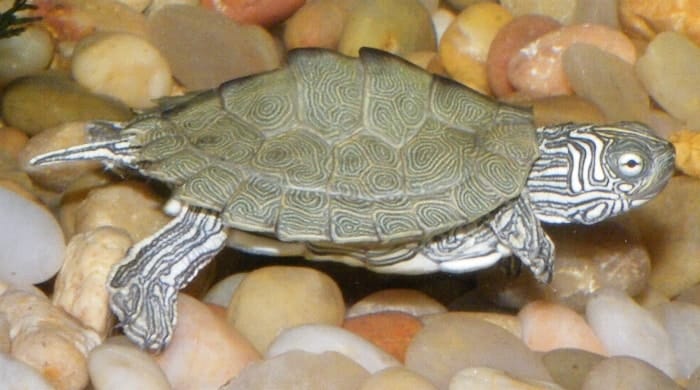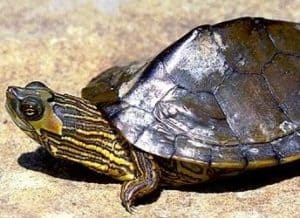Graptemys caglei (Cagle’s Map Turtle)
Home > Turtle Database > Graptemys caglei (Cagle’s Map Turtle)

Cagle’s Map Turtle (Graptemys caglei) is a small to medium-sized freshwater turtle native to Texas, USA. Recognizable by its intricately patterned shell resembling a topographic map, this species inhabits clear, fast-flowing rivers and streams. Due to its limited range and specific habitat requirements, it has become a subject of conservation concern.
Native To These Regions
Texas (USA)Native Turtle Species Map – Find Turtles by Region
Scientific Classification
- Kingdom: Animalia
- Phylum: Chordata
- Class: Reptilia
- Order: Testudines
- Family: Emydidae
- Genus: Graptemys
- Species: Graptemys caglei
Common Names
- Cagle’s Map Turtle
- Guadalupe Map Turtle
This Hilarious Turtle Book Might Know Your Pet Better Than You Do
Let’s be real—most turtle care guides feel like reading a textbook written by a sleep-deprived zookeeper.
This one’s not that.
Told from the snarky point of view of a grumpy, judgmental turtle, 21 Turtle Truths You’ll Never Read in a Care Guide is packed with sarcasm, sass, and surprisingly useful insights.
And hey—you don’t have to commit to the whole thing just yet.
Grab 2 free truths from the ebook and get a taste of what your turtle really thinks about your setup, your food choices, and that weird plastic palm tree.
It’s funny, it’s honest, and if you’ve ever owned a turtle who glares at you like you’re the problem—you’ll feel seen.
Identification
Description
Cagle’s Map Turtle features an olive to brown carapace adorned with yellow to orange markings that resemble a map’s contour lines. The shell has a serrated rear edge and a pronounced dorsal keel. The plastron (underside) is lighter, usually yellowish. Its skin is dark with yellow stripes running along the neck, head, and limbs.
Sexual Dimorphism
Females are significantly larger than males, measuring up to 7 inches (18 cm) in carapace length, while males reach about 4 inches (10 cm). Males have longer tails and more elongated foreclaws compared to females.
Check more turtles from the Graptemys genus
Native Origin and Distribution
Geographical Range
This species is endemic to the Guadalupe River system in south-central Texas, including the Guadalupe, San Marcos, and Comal Rivers. Its restricted range makes it particularly susceptible to environmental changes.
Preferred Habitat
Cagle’s Map Turtle prefers clear, fast-flowing rivers and streams with abundant basking sites like logs and rocks. It thrives in areas with moderate to strong currents and a substrate of sand or gravel, which are essential for foraging and nesting.
Behavior
Feeding Habits
Primarily carnivorous, this turtle feeds on aquatic invertebrates such as snails, clams, and insects. Females, due to their larger size, can consume bigger prey, including hard-shelled mollusks. Males and juveniles tend to feed on smaller invertebrates.
Predators
Natural predators include raccoons, large fish, and birds of prey, which mainly threaten eggs and juveniles. Human activities, such as habitat destruction and pollution, also pose significant risks.
Reproduction
Breeding Season
Breeding occurs from spring to early summer, typically between April and July.
Reproductive Method
Females lay 5 to 12 eggs per clutch in nests dug into sandy or soft soil near water sources. The incubation period lasts about 60 to 70 days, with hatchlings emerging in late summer or early fall.
Conservation
Extinction Status
Cagle’s Map Turtle is listed as Vulnerable on the IUCN Red List due to its limited distribution and habitat threats.
Threats
- Habitat Degradation: Pollution, water extraction, and construction of dams disrupt their natural habitats.
- Illegal Collection: The pet trade has led to over-collection in some areas.
- Recreational Activities: Increased boating and tourism can lead to habitat disturbance.
Conservation Measures
- Legal Protection: Enforcement of wildlife protection laws to prevent illegal collection.
- Habitat Conservation: Efforts to preserve and restore river habitats.
- Public Awareness: Education programs to highlight the species’ plight and promote conservation.
Economic Importance
While not a major economic contributor, Cagle’s Map Turtle is occasionally sold in the pet trade due to its distinctive appearance. Ecologically, it helps control populations of aquatic invertebrates, contributing to the health of its freshwater ecosystem.
Interesting Facts
- Named after herpetologist Fred Ray Cagle, who extensively studied map turtles.
- Its intricate shell patterns make it one of the most visually striking turtles in North America.
- Serves as an indicator species, reflecting the overall health of its riverine habitat.

About Author
Muntaseer Rahman started keeping pet turtles back in 2013. He also owns the largest Turtle & Tortoise Facebook community in Bangladesh. These days he is mostly active on Facebook.














